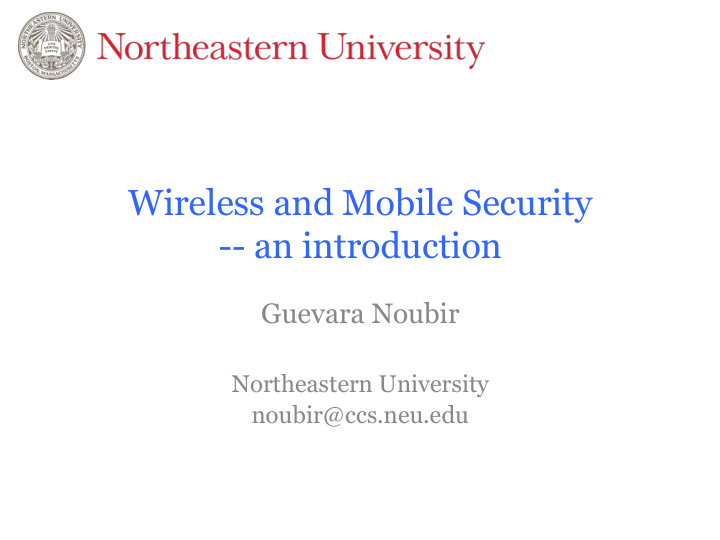



Wireless and Mobile Security -- an introduction Guevara Noubir Northeastern University noubir@ccs.neu.edu
Outline • Introduction to the topics • Structure of lectures • Logistics G. Noubir 2
Wireless Communications • Key technology of the Mobile Revolution G. Noubir 3
Ubiquity of Wireless & Mobile • Mobile Phones • Power Grid – Wireless Remote Terminal Units – GPS signals provide time synchronization information to timestamp samples. • Vehicle to Vehicle (DSRC) • Air Traffic Control • Home Automation • Wireless Sensor Networks / Internet of Things • Biomedical devices • Military Communications • Wireless Energy Transfer G. Noubir 4
Software Defined Radios • Wireless & Mobile, a traditionally EE discipline, is increasingly driven by CS (algorithms & applications) • Information Theory was founded by Claude Shannon (1948) – In his MS Thesis “electrical applications of boolean algebra could construct and resolve any logical, numerical relationship” (1937) USRP N210 HackRF G. Noubir 5
Technology • Radio – Architectures/Protocols: Cellular, WLAN, PAN, WSN/IoT, RFID, GPS, Satellite, etc. – Building Blocks: Antenna, Power Amplifier, Filters, Mixers (Down/Up conversion), Modulation, Coding, access control, link adaptation, encryption, etc. • Devices – Sensors – Security modules e.g., USIM – Operating System – Applications G. Noubir 6
Unique Characteristics • Wireless – Broadcast medium – Limited RF spectrum • Mobile – Architectures & Protocols that support access from anywhere – Limited energy • Emergence of Mobile + Cloud architectures G. Noubir 7
Security Risks & Challenges • Information leakage – Data – Traffic patterns – Location • Denial of service – Limited resources => complex control mechanisms • Challenges – Large attack surface, numerous sensors, significant PII, limited battery & computation, coupling of networks, critical infrastructure G. Noubir 8
Long history of attacks • Great Seal Bug (Aug. 4, 1945) • Cordless phones • GSM • WEP, WPA Enterprise, WPS • GPS – Power grid, air traffic G. Noubir 9
Course Lectures • Part I – Review of Network Security: from Crypto to Security Protocols – Fundamentals of Wireless & Mobile Systems: key features and mechanisms of wireless and mobile systems – Security Standards in current Wireless & Mobile Systems: WiFi Security (WEP, WPA, WPA-Enterprise); Cellular Security (GSM, 3G, LTE); Internet of Things / Wireless Sensor Networks / RFID – Emerging Privacy concerns: location, tracking, traffic analysis, mobile and the cloud • Part II – Wireless and Mobile as a Cyber Physical Infrastructure (CPS) – Denial of Service and Spoofing Attacks Cellular, WiFi, GPS – Implications to CPS: e.g., Electricity grid, Internet of Things • Part III – Security of Mobile Computing Platforms – Android and iOS security models – Threats and emerging solutions (e.g., side channel attacks) G. Noubir 10
Recommend
More recommend